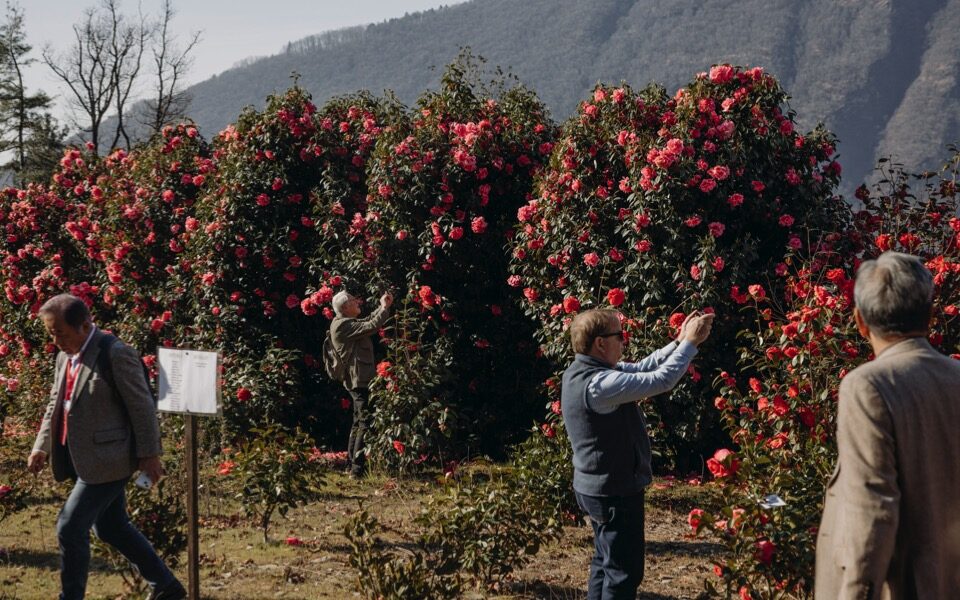Italian town hitches its wagon to plants that bloom (even in winter)

VERBANIA, Italy – Even as the group of flower aficionados flitted around a high-ceilinged room admiring just-clipped camellias with fanciful names like “Pink Lassie” and “Paradise Petite,” single petals floated lazily to the paneled wood floor, forming colorful mounds.
“You only have to look at a sasanqua and it loses its petals,” said Gianmario Motta, the president of the International Camellia Society and one of the world’s leading experts on the sasanqua, a camellia species native to Asia that blooms during the winter.
Indeed, these camellias’ star turn as the protagonists of the Winter Camellia Exhibition in Verbania, a northern Italian lakefront town not far from the Swiss border, was booked for a mere weekend, a brief moment in the limelight before they withered away.
But if the exhibit, showcased in a 19th-century villa, was necessarily short-lived, Verbania’s administrators have more ambitious plans involving a plant that has thrived on the lake since it made its first appearance here almost 200 years ago. In recent decades, the cultivation of camellias, as well as other ornamental plants like azaleas and rhododendrons, has become a mainstay of the local economy, while lush gardens and parks in and around Verbania have attracted legions of those who appreciate nature, particularly plants.
The camellia “is the excellence of Lake Maggiore and of Verbania,” the town’s mayor, Silvia Marchionini, said in opening the exhibit in late November. “The history and the floriculture in this territory represent a valuable asset to be cherished and also to grow,” she added, as officials work to bolster Verbania’s tourism season beyond its traditional start with spring blossoms in March.
Motta chimed in that “2023 was a great year for Verbania and for the camellia.” His International Camellia Society, which promotes knowledge, cultivation and development of camellias, held its biannual world congress here last spring, with camellia lovers alternating visits to local gardens with the presentation of papers on petal blight and other plant catastrophes.
Verbania also inaugurated a public camellia park featuring hundreds of varieties in the garden of a villa abutting the town’s auditorium on the lake. A room dedicated to books on camellias is expected to open in the villa itself, which is also the town’s library. The park was dedicated to Pietro Hillebrand, a local expert known as “the gentleman of the camellias,” who died in 2019.
“You do this for passion,” said Valeria Sibilia, since 2000 the president of the Verbania Garden Club, which helped establish the park. On an afternoon in November she gently scolded a group of Pakistani cricket players who had set up among some of the nascent plants of the villa. They cheerfully moved away. “It’s important to respect the plants,” she said.
Lake Maggiore’s love affair with this hardy plant took off not too long after camellias first arrived in Italy. Lore has it that camellias were introduced to the Bourbon rulers of Naples around the 1780s by British naval commander Horatio Nelson (if truth be told, the dates are a bit off, historically).
The provenance of the plants (mostly from Japan) “gave camellias a certain aura” of exoticism, said Daniele Bosi, director for Italy of the International Camellia Society, and they quickly became a favorite of the aristocracy, who collected and gave the plants, which propagated easily, as gifts.
By the mid-19th century, “camellia mania” had trickled down to the bourgeoisie. Its popularity coincided with the Risorgimento, as the unification of Italy is known. Nurseries and breeders dedicated new camellias to the movement’s leaders, like Giuseppe Garibaldi (two cultivars are dedicated to him) and King Victor Emmanuel II and his offspring.
Moreover, the dominant colors of camellias – white and red – plus the green of the leaves were reminders of the Italian flag. “We think that is one reason the camellia became so popular during the unification,” Andrea Corneo, the president of the Italian Camellia Society, explained at the congress last year.
On Lake Maggiore, camellias thrived in the mild microclimate and a soil with an acidity conducive to their growth. Wealthy residents from nearby Milan and Turin filled the landscaped gardens of their summer homes with ornamental varieties, vying to create the richest collections.
It wasn’t always rosy. There was a lull in popularity in the early 1900s, before Italian enthusiasts revived interest in the 1960s, and on Lake Maggiore, camellias now flourish not only in private gardens but also in condominium courtyards, roundabouts and many other public areas.
Corneo said a recent visitor from England had been surprised to find camellias to be such a prominent part of the urban greenery. Where she came from, “they’re relegated to botanical gardens and seen as a rarity,” he said.
Corneo and his family own the Villa Anelli, one of the most historic camellia gardens in Italy, with dozens of species, including 50 winter camellias. The founder of the villa’s collection, Antonio Sevesi, co-wrote the International Camellia Register, a compilation of varieties that is still in use today. Corneo provided several of the cultivars planted at the new camellia park in Verbania.
Last spring, camellia enthusiasts from around the world traipsed through the Villa Anelli, as well as other historic gardens, to admire rare specimens.
At the Savioli nursery on a hill overlooking Verbania, the group got lost among some 700 camellia varieties, both ancient and modern. “Who knows what this bee crossed with,” said Lara Savioli, the daughter of one of the nursery’s owners, pointing at a multicolored camellia where various hues vied for attention. “It’s a bit of an anarchic pollination,” she said.
Visitors from abroad were impressed.
“It’s incredible. They don’t bloom like this in America, they don’t bloom this profusely,” said Mark Crawford of Valdosta, Georgia, a plant pathologist. “Our climate’s so different.”
Crawford is working with the U.S. Department of Agriculture on a project to import camellia azaleas from China, and those plants are quarantined for two years in Beltsville, Maryland, because they can be a host to a citrus pest. So “they’re in jail,” he said with a laugh. “There are real strict rules.”
Another congress attendee, Forrest S. Latta, a lawyer from Mobile, Alabama, said that while he grew camellias back home, those in Verbania were bigger, which he attributed to higher elevation, more sunlight and drainage that emulates the mountain slopes of China and Japan, where many varieties originate. “The camellias are in heaven, so we’re in heaven,” he said. “If one were looking for an Uffizi for camellias, they’d come to a place like this,” he added, referring to the famous gallery in Florence.
“There’s always been tourism attentive to botany, and it’s always been present in Verbania, which for many years lived off plant nurseries and their exports,” said Roberto Ferrari, the director of Villa Taranto, a botanical garden in Verbania that is considered one of Italy’s finest gardens. It is among Verbania’s major tourist attractions, along with the Borromean Islands, named for the family that still owns two of them, both landscaped with rich botanical gardens. With more than 1 million visitors a year, the province of Verbania is the second most visited attraction in Piedmont, behind Turin, said Marchionini, the mayor.
“In recent decades we’ve invested a lot in tourism because of the excellence of our landscape, nature, beaches, cycling paths and historic hotels,” she said in an interview. “It’s not just our identity, it’s an economic scenario.”
“We’re a little paradise,” she said.
This article originally appeared in The New York Times.






